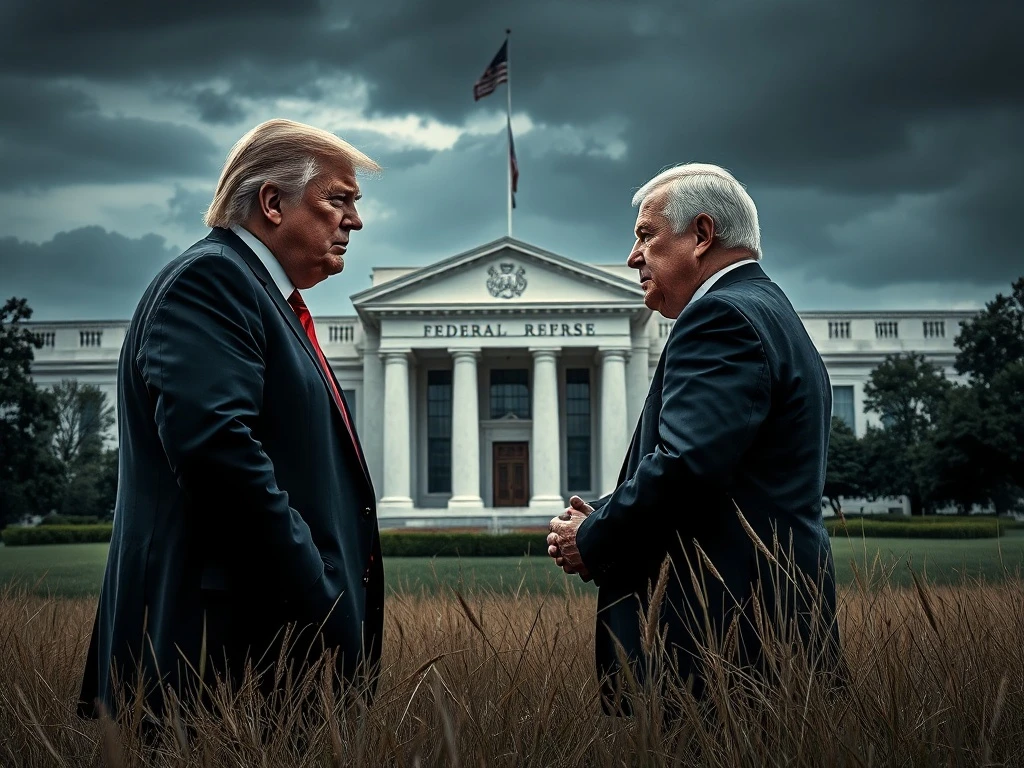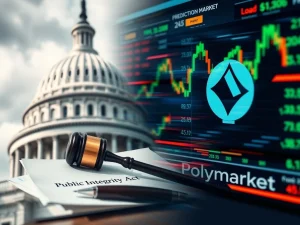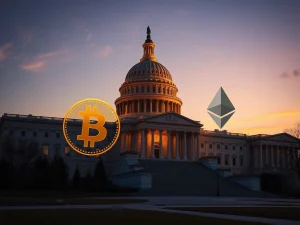Federal Reserve Under Pressure: Trump Unleashes Demands for Crucial Rate Cuts

In the often unpredictable world of global finance, few events spark as much debate as direct political intervention in central bank affairs. Recently, the spotlight has fallen squarely on the Federal Reserve as former President Donald Trump intensified his public demands for interest rate cuts. This isn’t just a political spat; it’s a high-stakes drama with profound implications for markets worldwide, including the volatile realm of cryptocurrencies. What does this unprecedented pressure mean for the Fed’s independence and the future of economic stability?
The Battle for Federal Reserve Independence: A High-Stakes Showdown
The scene was set for an extraordinary confrontation on July 24, 2025, as former U.S. President Donald Trump made a rare visit to the Federal Reserve headquarters. This wasn’t a cordial meeting; it was a direct challenge to the central bank’s long-cherished autonomy. Trump’s public call for lower interest rates aimed to stimulate economic growth, reflecting a consistent theme from his previous administration. For nearly two decades, no sitting president had visited the Fed, underscoring the gravity of this encounter. The tension was palpable, highlighting the delicate balance between political desires and the independent mandate of the central bank.
- A Rare Presidential Visit: Trump’s presence at the Fed’s HQ was a symbolic act, designed to amplify his message.
- Direct Criticism: He openly criticized the Fed’s policy stance and even its renovation project, framing it as budget mismanagement.
- Powell’s Measured Response: Chair Jerome Powell navigated the situation with composure, correcting factual inaccuracies while steadfastly defending the Fed’s institutional autonomy. This strategic approach aimed to maintain credibility without escalating the confrontation.
Navigating Interest Rates: Why Trump Demands Cuts
At the heart of Trump’s demands lies a clear objective: to push down interest rates. For seven consecutive months, the Federal Reserve had maintained rates at 4.3%, a level Trump views as too restrictive for the economy. His argument centers on the belief that lower rates would unleash a wave of economic activity, making borrowing cheaper for businesses and consumers, thereby stimulating investment and job creation.
- Stimulating Growth: Trump’s primary rationale is that lower rates will act as a catalyst for faster economic expansion.
- Historical Precedent: Presidents often prefer lower rates to boost short-term economic performance, especially heading into elections.
- Budget Overruns Critique: Beyond rates, Trump also used the opportunity to critique the Fed’s $2.5 billion renovation project, tying it to broader concerns about government spending. While Powell clarified the costs were from a prior initiative, the exchange highlighted Trump’s focus on fiscal accountability.
The Intricacies of Monetary Policy: Powell’s Data-Driven Stance
While Trump pushes for immediate cuts, Federal Reserve Chair Jerome Powell consistently emphasizes a data-driven approach to monetary policy. This means decisions on interest rates are based on a thorough analysis of economic indicators such as inflation, employment figures, and GDP growth, rather than political expediency. The Fed’s dual mandate is to achieve maximum employment and maintain price stability, and sudden, politically motivated rate changes could jeopardize these goals.
- Inflationary Risks: Cutting rates too soon could reignite inflation, eroding purchasing power and destabilizing markets.
- Market Repercussions: Unpredictable policy shifts, especially those perceived as politically influenced, can trigger market volatility, affecting everything from stock prices to bond yields and even the stability of digital assets.
- Credibility at Stake: The Fed’s independence is paramount to its credibility. Yielding to political pressure could undermine trust in its ability to make sound economic decisions, leading to long-term instability.
Jerome Powell: Steadfast Amidst Political Storms
Throughout the escalating pressure, Jerome Powell has maintained a remarkably consistent and stoic demeanor. Despite Trump’s earlier hints about potentially removing him from office – a notion Trump later called ‘highly unlikely’ during the visit – Powell has remained committed to the Fed’s institutional autonomy. His responses have been carefully calibrated, correcting inaccuracies without directly confronting the president in a way that would further politicize the central bank.
- Balancing Act: Powell’s challenge is to balance transparency with the need to uphold the Fed’s independence, ensuring markets and the public trust its decisions.
- Commitment to Mandate: He continually reiterates the Fed’s focus on its dual mandate, prioritizing long-term economic stability over short-term political gains.
- Upcoming Decision: The upcoming July 29–30 meeting will be a crucial test, demonstrating whether Powell’s insistence on data-driven decisions can withstand the intensified executive branch pressure.
Impact on Economic Growth: What’s at Stake?
The ongoing debate between the White House and the Federal Reserve has significant implications for economic growth and stability. While Trump argues that lower rates are the key to unlocking prosperity, the Fed’s cautious stance reflects concerns about overheating the economy or creating asset bubbles. The tension between political influence and monetary policy is a critical factor in maintaining long-term economic health.
- Market Reactions: Markets initially reacted nervously to Trump’s earlier remarks about Powell, with stocks falling and bond yields rising, before stabilizing once the president clarified his stance. This highlights how sensitive markets are to perceived threats to Fed independence.
- Broader Debates: The visit also brought to light broader discussions about federal spending and institutional accountability, with Trump’s critique of the Fed’s renovation costs aligning with his skepticism of government expenditures.
- The Delicate Balance: The outcome of the Fed’s July rate decision will be a significant indicator of the limits of its independence and the extent to which political rhetoric can truly influence monetary policy in an era of heightened executive-legislative tensions. The world, including the crypto community, watches closely, understanding that these decisions ripple through all financial assets.
The recent confrontation between former President Trump and Federal Reserve Chair Powell underscores a fundamental tension at the heart of modern economies: the balance between political will and independent monetary policy. While Trump champions aggressive rate cuts for perceived immediate economic boosts, Powell steadfastly adheres to a data-driven approach, prioritizing long-term stability and inflation control. The Fed’s upcoming decision will not only shape the trajectory of the U.S. economy but also serve as a powerful testament to the resilience of its independence. For investors, particularly in volatile markets like cryptocurrency, understanding these macroeconomic undercurrents is paramount, as central bank decisions inevitably influence market sentiment and asset valuations.
Frequently Asked Questions (FAQs)
Q1: Why is former President Trump pressuring the Federal Reserve to cut interest rates?
A1: Former President Trump believes that lower interest rates would stimulate economic growth by making borrowing cheaper for businesses and consumers, thereby encouraging investment and job creation. He views the current rate of 4.3% as too restrictive.
Q2: What is the Federal Reserve’s primary role regarding interest rates?
A2: The Federal Reserve’s primary role is to manage monetary policy to achieve its dual mandate: maximum employment and price stability (controlling inflation). Its decisions on interest rates are based on economic data, aiming for long-term economic health rather than short-term political objectives.
Q3: How does the Fed maintain its independence from political influence?
A3: The Federal Reserve is designed to operate independently of direct political influence to ensure its decisions are based on economic fundamentals rather than political cycles. Its leaders are appointed for fixed terms, and its funding comes from its own operations, not congressional appropriations. Chair Powell’s measured responses in the face of pressure exemplify this commitment.
Q4: What are the potential risks of cutting interest rates too quickly or due to political pressure?
A4: Cutting rates too quickly or under political pressure could lead to several risks, including reigniting inflation, creating asset bubbles, and undermining the Fed’s credibility. Such actions could also trigger market volatility and economic instability in the long run.
Q5: How might the Federal Reserve’s decision on interest rates impact cryptocurrency markets?
A5: While not directly regulated by the Fed, cryptocurrency markets are often influenced by broader macroeconomic conditions. Lower interest rates can sometimes make riskier assets, like cryptocurrencies, more attractive as investors seek higher returns. Conversely, higher rates or economic uncertainty can lead to a flight to safer assets or a decrease in speculative investment. The Fed’s decisions significantly impact overall market sentiment and liquidity.
Q6: When is the next Federal Reserve meeting where interest rates will be discussed?
A6: According to the article, the Federal Reserve’s next meeting where interest rates will be discussed is scheduled for July 29–30. This meeting will be crucial in determining the Fed’s stance amidst ongoing political pressure.









